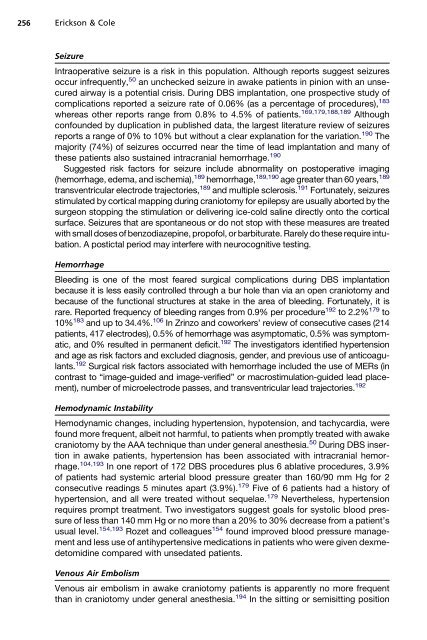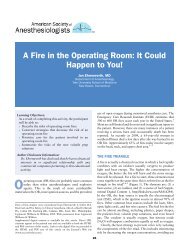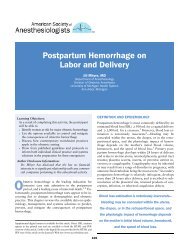Anesthetic Considerations for Awake Craniotomy for Epilepsy ... - Vtr
Anesthetic Considerations for Awake Craniotomy for Epilepsy ... - Vtr
Anesthetic Considerations for Awake Craniotomy for Epilepsy ... - Vtr
Create successful ePaper yourself
Turn your PDF publications into a flip-book with our unique Google optimized e-Paper software.
256<br />
Erickson & Cole<br />
Seizure<br />
Intraoperative seizure is a risk in this population. Although reports suggest seizures<br />
occur infrequently, 50 an unchecked seizure in awake patients in pinion with an unsecured<br />
airway is a potential crisis. During DBS implantation, one prospective study of<br />
complications reported a seizure rate of 0.06% (as a percentage of procedures), 183<br />
whereas other reports range from 0.8% to 4.5% of patients. 169,179,188,189 Although<br />
confounded by duplication in published data, the largest literature review of seizures<br />
reports a range of 0% to 10% but without a clear explanation <strong>for</strong> the variation. 190 The<br />
majority (74%) of seizures occurred near the time of lead implantation and many of<br />
these patients also sustained intracranial hemorrhage. 190<br />
Suggested risk factors <strong>for</strong> seizure include abnormality on postoperative imaging<br />
(hemorrhage, edema, and ischemia), 189 hemorrhage, 189,190 age greater than 60 years, 189<br />
transventricular electrode trajectories, 189 and multiple sclerosis. 191 Fortunately, seizures<br />
stimulated by cortical mapping during craniotomy <strong>for</strong> epilepsy are usually aborted by the<br />
surgeon stopping the stimulation or delivering ice-cold saline directly onto the cortical<br />
surface. Seizures that are spontaneous or do not stop with these measures are treated<br />
with small doses of benzodiazepine, propofol, or barbiturate. Rarely do these require intubation.<br />
A postictal period may interfere with neurocognitive testing.<br />
Hemorrhage<br />
Bleeding is one of the most feared surgical complications during DBS implantation<br />
because it is less easily controlled through a bur hole than via an open craniotomy and<br />
because of the functional structures at stake in the area of bleeding. Fortunately, it is<br />
rare. Reported frequency of bleeding ranges from 0.9% per procedure192 to 2.2% 179 to<br />
10% 183 andupto34.4%. 106 In Zrinzo and coworkers’ review of consecutive cases (214<br />
patients, 417 electrodes), 0.5% of hemorrhage was asymptomatic, 0.5% was symptomatic,<br />
and 0% resulted in permanent deficit. 192 The investigators identified hypertension<br />
and age as risk factors and excluded diagnosis, gender, and previous use of anticoagulants.<br />
192 Surgical risk factors associated with hemorrhage included the use of MERs (in<br />
contrast to “image-guided and image-verified” or macrostimulation-guided lead placement),<br />
number of microelectrode passes, and transventricular lead trajectories. 192<br />
Hemodynamic Instability<br />
Hemodynamic changes, including hypertension, hypotension, and tachycardia, were<br />
found more frequent, albeit not harmful, to patients when promptly treated with awake<br />
craniotomy by the AAA technique than under general anesthesia. 50 During DBS insertion<br />
in awake patients, hypertension has been associated with intracranial hemorrhage.<br />
104,193 In one report of 172 DBS procedures plus 6 ablative procedures, 3.9%<br />
of patients had systemic arterial blood pressure greater than 160/90 mm Hg <strong>for</strong> 2<br />
consecutive readings 5 minutes apart (3.9%). 179 Five of 6 patients had a history of<br />
hypertension, and all were treated without sequelae. 179 Nevertheless, hypertension<br />
requires prompt treatment. Two investigators suggest goals <strong>for</strong> systolic blood pressure<br />
of less than 140 mm Hg or no more than a 20% to 30% decrease from a patient’s<br />
usual level. 154,193 Rozet and colleagues154 found improved blood pressure management<br />
and less use of antihypertensive medications in patients who were given dexmedetomidine<br />
compared with unsedated patients.<br />
Venous Air Embolism<br />
Venous air embolism in awake craniotomy patients is apparently no more frequent<br />
than in craniotomy under general anesthesia. 194 In the sitting or semisitting position




